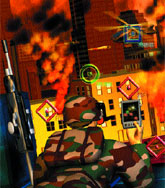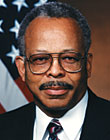The Defense Department's oft-stated vision for the future of combat thrusts information technology to the fore, embracing concepts such as network-centric warfare and digital battlefields.The reality is that there are plenty of stumbling blocks keeping the military from achieving that vision.The department is weighed down by a mass of programs, and there is entrenched resistance to change, according to officials in both DOD and industry. Plus, many IT-critical initiatives lack funding and have become bogged down by procurement procedures.Performance measures that would weed out unproductive programs are nonexistent. And many Defense systems aren't interoperable.Come Sept. 30, the debate is likely to take a new direction when Defense Secretary Donald Rumsfeld delivers his long-awaited and already controversial 2001 Quadrennial Defense Review.'The vision is [of] the robust, reliable, assured information infrastructure required to conduct warfare in the 21st century,' said Paul Brubaker, former deputy chief information officer for DOD. 'The articulation of the goal has been OK. The huge gap has been in backing that vision with resources. In other words, directing and steering resources toward achieving the vision.'Brubaker, who heads electronic-government services for Commerce One Inc. of Pleasanton, Calif., ascribes the problem to an absence of effective leadership.'It's been the inability to manage to the vision,' he said. 'They just haven't done it.'Moreover, Brubaker said, resistance to reform at the Pentagon and in Congress has blurred the vision.'You've got a lot of folks who have made their careers operating in the old way, and they're protecting their turf,' he said. 'Then you've got Congress. They don't really understand the big picture, and they'll start meddling in management's ability to get the job done.'French Caldwell, a former special projects officer for the secretary of the Navy and now research director for technology and public policy for Gartner Inc. of Stamford, Conn., agreed.'There's a huge mismatch between the vision and the force structure that's actually being funded,' Caldwell said. 'No one wants to divert the money because it jeopardizes current programs.'This is not to say that the outlook is entirely gloomy. Caldwell pointed to the Navy-Marine Corps Intranet as a bright spot.'It's the biggest IT project ever funded by the federal government,' he said, referring to the $6.9 million NMCI contract. 'You can buy half a dozen B-2 bombers with that. It's a big shift to see that type of funding and focus on creating a cohesive, collaborative network.'Brubaker concurred. 'The department needs to do more things like NMCI, which is a bold-stroke effort,' he said.In addition, the Army recently announced plans to centralize systems management at about two dozen major commands under the service's CIO.'A long time ago in the IT world, people weren't really concerned about the larger enterprise,' said Miriam Browning, the Army's principal director for enterprise integration in the office of the Army's CIO. 'We're now saying that we need to manage this as a single network.'The program is aimed at 'reducing our IT footprint instead of having thousands and thousands of servers,' she said.Any further plans might hinge on Rumsfeld's Quadrennial Defense Review.The QDR will outline the Bush administration's goals for reshaping the military to contend with emerging threats in the post-Cold War world, including rogue states using long-range missiles, terrorism and cyberattacks.The QDR also is likely to be a signpost for the direction IT will take at Defense.There seems to be little doubt that the review will expand the vision of network-centric warfare, making IT more intrinsic than ever to future Defense systems.'I think there will be a much greater reliance on IT and a good acknowledgement of the importance of IT as it relates to the warfighting mission and the business mission,' Browning said.Anthony Valletta, a vice president at SRA International Inc. of Arlington, Va., and a former Defense official, expects the QDR to reconfirm and increase the role of command, control, communications, computers and intelligence in warfare.'Having better eyes and better ears means that you put steel on target faster and kill the target the first time, which saves money in the long run because you don't have to shoot the second, third and fourth rounds,' Valletta said.It will mean 'the full exploitation of IT,' said Emmett Paige Jr., president and chief operating officer of OAO Corp. of Greenbelt, Md., and former assistant secretary of defense for 3CI.The QDR has been the center of controversy, mostly over rumors that it will propose reductions in the size of the military, including cuts in troops and conventional weapons systems.Opposition to such cuts is coming from inside the Pentagon and from Congress.In a recent QDR update at the Pentagon, Gen. Richard Myers, vice chairman of the Joint Chiefs of Staff, denied that uniformed leadership has tried to impede reform efforts. 'I think there is a consensus that change is required,' he said.Myers conceded that there have been 'passionate arguments' about cuts and that getting 'through this paradigm shift is really tough work.'Earlier this month, a majority of the members of the House Armed Services Committee warned Rumsfeld against trying to reduce the size of military.Whatever reforms the QDR proposes, most observers agree that some reduction in force size is inevitable, sooner or later.And a downsizing in forces more than likely means upsizing for IT, by most accounts.'It will probably mean more reliance on automated systems,' Brubaker said.'One of the core principles of warfare is concentration of force,' Caldwell said. 'Network-centric warfare goes against that core principle. If you're downsizing your forces, concentration of force gets harder and harder to achieve. Yet with information technology, you get virtual concentration [of] force.'Many see the increasing role of technology as contributing to reductions in force size.'It's the idea that IT is going to help leverage smaller and smaller forces,' Caldwell said.Ray Bjorklund, a vice president at Federal Sources Inc. of McLean, Va., added, 'There will be a strategic shift in thinking'fewer forces and relying more on the richness of IT.'Sources also expect Rumsfeld's QDR to call for tougher requirements in the IT acquisition process, promoting the principles of the Information Technology Management Reform Act of 1996, which underscored lifecycle management of systems as capital investments.'You've got people in place [in the Bush administration] now from the Clinger-Cohen generation,' Valletta said. 'You're going to see a re-emphasis in the areas of enterprise architectures, capital planning, performance measures and return on investment.'He added: 'I believe that programs like NMCI, which have to meet service-level agreements, are going to be very critical. Those service-level agreements are basically performance measures. NMCI is going to be watched very carefully. If it doesn't meet the performance measures, then the Office of Management and Budget and the Congress are going say: 'Why should we give you the money if you're not showing the return?' 'Other observers also see performance-based contracting as key to DOD advancing toward its vision.'I think you're going to see less of IT the product and more of IT the enabler,' said Chip Mather, senior vice president of Acquisition Solutions Inc. of Chantilly, Va. 'For years we were buying PCs. Now we're buying service-level agreements. That will become more and more essential to Defense meeting its mission.'The lack of interoperability among military systems and the need for an overarching network is another hurdle Rumsfeld faces.He knows it. In a recent interview, he declared that the military needs information dominance and information interoperability to address future threats.'We still have a lot of disparate systems out there among the services,' Valletta said. 'I think joint interoperability is still one of the most critical issues the department faces.'The services also need to integrate back-office and support networks such as personnel, finance and logistics systems, Paige said.DOD spends a lot of money on IT and software systems in these areas, he said. 'I'm convinced that we're wasting billions of dollars every year with all of these different functional systems,' Paige said. 'Every dollar we save will help us modernize and protect the interests of the nation.'Can Defense begin to make real progress toward its digital vision?'I know that at the top of the organization, their hearts are in the right place,' Brubaker said. 'They definitely want to move the department into the 21st century. But it will be a hell of a challenge.'
'I'm convinced that we're wasting billions of dollars every year with all of these different functional systems,' Paige said. 'Every dollar we save will help us modernize and protect the interests of the nation.'
'A long time ago in the IT world, people weren't really concerned about the larger enterprise,' Browning said. 'We're now saying that we need to manage this as a single network.'
'I know that at the top of the organization, their hearts are in the right place,' Brubaker said. 'They definitely want to move the department into the 21st century. But it will be a hell of a challenge.'










